| Srl | Item |
| 1 |
ID:
097392


|
|
|
|
|
| Publication |
New Delhi, Manas Publications, 2010.
|
| Description |
436p.
|
| Standard Number |
9788170493655, hbk
|
|
|
|
|
|
|
|
|
|
|
|
Copies: C:1/I:0,R:0,Q:0
Circulation
| Accession# | Call# | Current Location | Status | Policy | Location |
| 055031 | 355.14/USA 055031 | Main | On Shelf | General | |
|
|
|
|
| 2 |
ID:
167081
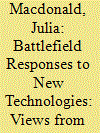

|
|
|
|
|
| Summary/Abstract |
How do individuals on the battlefield respond to the introduction of new technologies? How will unmanned and increasingly autonomous technologies be received by ground combat personnel? In this paper we explore tactical-level perceptions of one particular technology—armed unmanned aerial vehicles (UAVs)—by conducting a survey experiment of ground fires controllers. Our findings reveal that these personnel have strong behavioral reactions to the introduction of unmanned technology. Especially in situations with high risk to ground troops, we find a strong preference for manned aircraft with implications for the future use of UAVs and human–machine relationships in war. These results suggest the need to incorporate behavioral variables into future studies of military adoption and innovation and indicate that the future adoption of unmanned systems may be just as much about the “warm fuzzy” of trust as confidence in unmanned capabilities.
|
|
|
|
|
|
|
|
|
|
|
|
|
|
|
|
| 3 |
ID:
174873
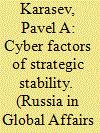

|
|
|
|
|
| Summary/Abstract |
It is hard to disagree with most international relations experts that nuclear arms control is currently undergoing a systemic crisis. Opinions differ on its depth and possible ways out of it. At the same time, many experts consider it necessary to conceptualize the factor of the latest information and communications technologies (ICTs), including artificial intelligence (AI) systems, in the domain of strategic stability. The matter concerns not only the digitalization of nuclear communications, command, control, and intelligence systems (C3I), but also the development and use of lethal autonomous weapons systems (LAWS).
|
|
|
|
|
|
|
|
|
|
|
|
|
|
|
|
| 4 |
ID:
103318
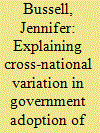

|
|
|
|
|
| Publication |
2011.
|
| Summary/Abstract |
New information and communication technologies provide governments with opportunities to deliver public services more effectively to their citizens. But we know little about the reasons for variation in the adoption of these technologies across countries. Using cross-national data on government use of information technologies to reform public service delivery, or eGovernment, I argue that politicians' expectations about the effects of more transparent service delivery on established patterns of rent-seeking play an important role in shaping variation in the character of reforms. I show that the level of preexisting corruption in a country is a robust predictor of eGovernment outcomes, with more corrupt governments less likely than their less corrupt peers to implement high-quality public service reforms using information technology. This finding contrasts with those analyses that emphasize the role of economic conditions or regime type in explaining technological diffusion.
|
|
|
|
|
|
|
|
|
|
|
|
|
|
|
|
| 5 |
ID:
173297
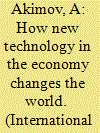

|
|
|
|
|
| Summary/Abstract |
THE PRODUCTIVE FORCES of any society come together in a trio of components: natural resources, human labor and capital (or tools of labor), and technology. The significance of these three components underwent radical changes with the onset of the industrial revolution of the 18th century, and the development of machine production dramatically increased the role of capital and technology in the economic production cycle.
|
|
|
|
|
|
|
|
|
|
|
|
|
|
|
|
| 6 |
ID:
154959
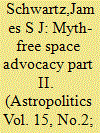

|
|
|
|
|
| Summary/Abstract |
Space advocates commonly compare the settling of the “space frontier” to the settling of the “western frontier” in the United States, arguing that space settlement will realize the same benefits purportedly realized by the western expansion of the United States: the generation of new cultures; the development of new technologies; and the empowerment of democratic governance. However, much of the reasoning here is based on a faulty understanding of history and on an overly optimistic view of what it will be like to live in a space settlement. Thus, I argue that ardent faith in the promises of settling the space frontier is a mythological belief, rather than a well-confirmed one.
|
|
|
|
|
|
|
|
|
|
|
|
|
|
|
|
| 7 |
ID:
127928
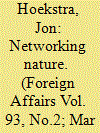

|
|
|
|
|
| Publication |
2014.
|
| Summary/Abstract |
Conservation is for the first time beginning to operate at the pace and on the scale necessary to keep up with, and even get ahead of, the planet's most intractable environmental challenges. New technologies have given conservationists abilities that would have seemed like super powers just a few years ago. We can now monitor entire ecosystems -- think of the Amazon rainforest -- in nearly real time, using remote sensors to map their three-dimensional structures; satellite communications to follow elusive creatures, such as the jaguar and the puma; and smartphones to report illegal logging.
|
|
|
|
|
|
|
|
|
|
|
|
|
|
|
|
| 8 |
ID:
172900
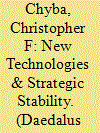

|
|
|
|
|
| Summary/Abstract |
A variety of new technologies, ranging from broad enabling technologies to specific weapon systems, may threaten or enhance strategic stability. In this essay, I analyze a technology's potential to significantly affect stability along three axes: the pace of advances in, and diffusion of, this technology; the technology's implications for deterrence and defense; and the technology's potential for direct impact on crisis decision-making. I apply this framework to examples including hypersonic weapons, antisatellite weapons, artificial intelligence, and persistent overhead monitoring. Formal arms control to contain dangers posed by some of these seems technically possible, though currently politically difficult to achieve. Others, particularly enabling technologies, resist arms control based on effective verification. The major powers will therefore instead have to find other ways to cope with these technologies and their implications. These options should include exchanges with potential adversaries so that pathways to nuclear escalation, and possible mitigating steps, can be identified and discussed.
|
|
|
|
|
|
|
|
|
|
|
|
|
|
|
|